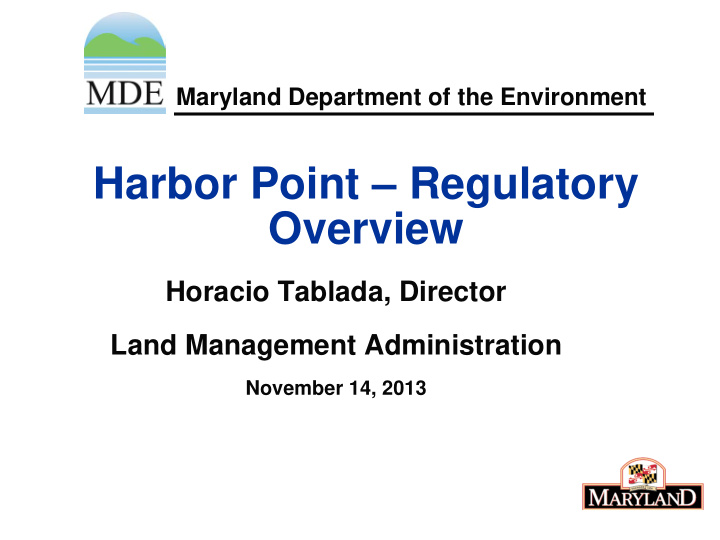



Maryland Department of the Environment Harbor Point – Regulatory Overview Horacio Tablada, Director Land Management Administration November 14, 2013
MDE’s Role Protect the environment and public health by reviewing the construction plan Ensure that construction would not undo the remedy already in place On going coordination with EPA
Historical facts • Chromium manufacturing began circa 1840s through mid 1980s • Initially chromium was mined in Baltimore County • Chromium ore was brought by vessels to the Chrome Works plant in Fells Point
Aerial Photograph (early 1970):
1989 Consent Decree • 09/29/1989- Signed between EPA/MDE & Allied-Signal; entered in federal court • Terms: – conduct investigations to determine nature and extent of contamination and migration from site; – submit a Corrective Measures Implementation Program Plan to prevent further contamination • Public comment period: 09/18 – 11/12/1991; public meeting: 10/28/1991
Site characterization/investigation • Investigations identified site conditions and the extent of contamination • Chromium was found in (no other contaminants above standards): – shallow groundwater at levels up to 14,500 mg/l (highest concentrations near the chemical manufacturing buildings) – deep groundwater at levels up to 8,000 mg/l (also highest near the chemical manufacturing buildings) – Studies found that contaminated groundwater had migrated away from the Site in the deep and shallow groundwater
Corrective actions • Dismantlement of buildings: most materials went to hazardous waste landfill in Hawkins Point (now closed); some materials (metals etc.) decontaminated and recycled. • Outboard embankment: a stone rip-rap structure around water-side to support old bulkheads • Hydraulic barrier: a bentonite wall surrounding the site to bedrock • Multi-media cap: geotextile fabric; clay layer; plastic liner; cover soil w/ demarcation fabric; and stone layer • Groundwater system: maintain a negative gradient
Corrective measure effectiveness • Chromium risks were determined by: – direct exposure to the contaminated soil through inhalation – exposure to contaminated surface water adjacent to site (62 lbs of Cr per day discharged into harbor) • Surface & groundwater monitoring around site • Remediation of contaminated groundwater outside wall was not required, “no known exposure” • Completion of Remedy: 06/21/1999 – Note: No further investigative or remedial work needs to be completed at this site
Brownfields/Redevelopment • Brownfield redevelopment has resulted in remediation of former contaminated properties and returned them to beneficial use; – very consistent with Smart Growth planning. • Brownfield redevelopment often occurs concurrently with remedial work; this site was remediated first. • Many former industrial sites like the GM Plant have been safely redeveloped in the Baltimore area under MDE’s oversight. • Harbor Point is a redevelopment project and not a site investigation or remedial project. • 02/05/2003: “Covenant Not to Sue” signed between Honeywell and EPA/MDE sets conditions for safe redevelopment. Amended: 8/22/2013 to include Harbor Point. • Morgan Stanley: Geotechnical report (2006); Detail Design Plan (2008); construction completed (2010).
Current status • June 2012: Conceptual design plan (CDP) submitted to EPA/MDE: – agencies provided comments and approved CDP January 2013. • July 2013: Detailed design plan (DDP) submitted to EPA/MDE: – agencies provided comments 10/31/2013; – revised DDP submitted 11/12/2013 (being reviewed). • Agencies are requesting use of CARB air sampling method for pre-construction chromium in ambient air.
Construction goals • MDE & EPA would ensure that public health and the environment are protected. – Construction should not undo the remedy already in place. Construction action levels would be set based on dust • particulate levels – would conservatively assume that Cr will be in dust, and be monitored throughout invasive activities. Actions to control dust or even shut down would be triggered by • conservative standards. EPA and MDE can adjust standards based on sample results as • construction progresses. • MDE plans to have inspectors present on-site during critical phases of the construction. • Post construction: EPA & MDE would maintain oversight, as monitoring will be always ongoing to ensure that the remedy is maintained.
MDE’s website screen shot • Here’s a portion of MDE’s webpage showing documents available by download or PIA request. • http://www.mde.state.md.us/ programs/Land/HazardousW aste/HazardousWasteHome/ Pages/AlliedChemical.aspx
Maryland Department of the Environment Land Management Administration Solid Waste Program 410-537-3315 MDE Project Coordinator: ed.dexter@maryland.gov 1800 Washington Boulevard | Baltimore, MD 21230-1718 410-537-3000 | TTY Users: 1-800-735-2258 www.mde.state.md.us
Recommend
More recommend